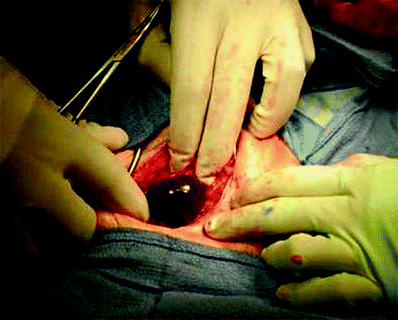Fig. 11.1
CT scan showing a left groin hernia. © Dale Dangleben, MD
Complications
Delayed diagnosis and treatment of a painful, tender, inflamed hernia can lead to bowel ischemia and perforation necessitating emergency surgery and possible bowel resection.
Management
Hernia Reduction
Hernia reduction is contraindicated if there are signs of strangulation. Strangulated hernias may be tense and tender with a blue or red discoloration to the overlying skin. Unfortunately, it may not be immediately apparent on examination whether or not a hernia is incarcerated. Duration of acute incarceration has been used to determine when strangulation has occurred and reduction is no longer safe; however, there is no consistency to the time reported for strangulation to occur with reported time ranging from 4 to 96 h. Subsequently, the only true contraindication to reduction is peritonitis. However, when there is doubt about the presence of strangulation, urgent surgical intervention as opposed to reduction is a recommended.
During bedside reduction (called taxus), conscious sedation may sometimes be required especially for pediatric patients. The patient is placed in the Trendelenburg position, and on occasion, ice application for several minutes in adults may help reduce edema and facilitate manual reduction. The proximal neck of the hernia is grasped with one hand and gentle pressure applied to the distal part of the hernia to guide it through the neck.
If the hernia is irreducible, emergent operative intervention is indicated. Those whose hernias are successfully reduced should undergo elective repair. In the not uncommon scenario of spontaneous reduction in a suspected strangulated hernia upon induction of anesthesia on the operating table, the surgeon should ensure bowel viability by exploring the abdominal cavity using laparotomy or preferentially using laparoscopy. One of the editors has explored the peritoneal cavity using a balloon trocar secured with a purse string from the preperitoneal space through the internal ring with good success. Compromised bowel is resected (Figs. 11.2 and 11.3).










